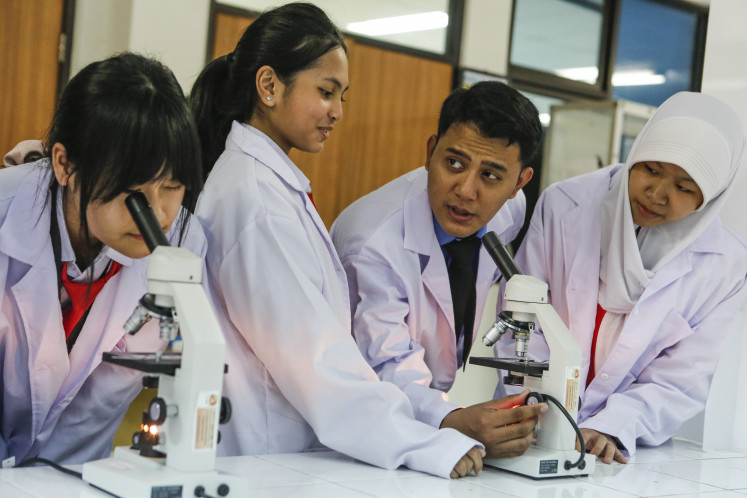Popular Reads
Top Results
Can't find what you're looking for?
View all search resultsPopular Reads
Top Results
Can't find what you're looking for?
View all search resultsIndonesia's development paradox
Indonesia is now the worldâs 10th-largest economy after the United States, China, India, Japan, Germany, Russia, Brazil, France and the United Kingdom
Change text size
Gift Premium Articles
to Anyone
I
ndonesia is now the world's 10th-largest economy after the United States, China, India, Japan, Germany, Russia, Brazil, France and the United Kingdom. According to a World Bank report, Indonesia recorded US$2,058 billion in gross domestic product (GDP-PPP) expenditure and $8,539 in GDP expenditure per capita in 2011, an increase from $707.9 billion in GDP expenditure and $3,234 in GDP expenditure per capita in 2005.
Not only does Indonesia rank high in terms of its economy, it is also a member of the prominent world forum, the G20. Both indicate the global acknowledgement of Indonesia's success in economic development that has been achieved under the administration of President Susilo Bambang Yudhoyono.
However, the success does not necessarily mean the same in terms of human development, as indicated by Indonesia's poor performance in several areas of the Millennium Development Goals (MDGs) ' in particular goal number five, which is to improve maternal health. One of the goal's targets is 'to reduce by three-quarters between 1990 and 2015 the maternal mortality ratio [MMR]'. As we come closer to the end of the MDG term in 2015, reducing the MMR seems to be the toughest target to achieve.
According to the MDGs, Indonesia should reduce its MMR from 390 per 100,000 live births in 1991 to 102 per 100,000 live births in 2015. We have achieved some progress, as shown by the 2007 MMR data of 228 per 100,000 live births, but in 2013 that figure had reportedly risen to 359 per 100,000 live births.
The poor MMR is in line with Indonesia's position on the Mothers' Index, which shows a country's performance in maternal and child mortality, expected years of schooling and the ratio of seats held by women in state legislatures.
According to Save the Children, Indonesia ranked 113th on the 2014 Mothers' Index, a decline from last year's level of 105 out of 178 countries surveyed.
This data shows that we lag behind in the women's reproductive health sector. The findings also demonstrate a disconnect between good economic performance and people's welfare, in particular women's. How could this happen?
In my view, part of the reason is alignment. On paper, development should prioritize marginal groups such as the poor, women and minorities. In practice, this may not be the case as the political sphere is often dominated by the rich, men and the majority.
As a result, policies and development programs tend to be designed to benefit those who dominate the political landscape. The marginalized are left behind as they have little say in development policies and programs.
Women in particular are marginalized due to Indonesia's deeply rooted patriarchy, which consigns them as second-class citizens. The high MMR and the low ranking on the Mother's Index in a 'developed' economy such as Indonesia's are ironic. This fact supports the notion that women do not receive a fair share of the fruits of development and are discriminated against socially, politically and economically.
While there are many factors that affect the high MMR, from an economic-political perspective it relates to the low state funding allocated to the health sector, which is only 3 percent of the total state budget, lower than the percentage stipulated in the 2009 Health Law of 5 percent. Thus, it means an even smaller amount of the budget is allocated for maternal health, making it ineffective to reduce the high MMR.
This fact mirrors a failure on gender mainstreaming in development ' especially in the health sector ' as mandated by Presidential Instruction No. 9/2000 on gender mainstreaming in national development and Home Ministerial Decree No. 132/2003 on guidelines on gender mainstreaming in regional development.
Negotiations on how much state budget funding is allocated to what sector is an economic-political battle. There are many interests that affect the negotiation process. With a low percentage of women representatives in policy-making bodies, women's voices are rarely heard and their needs are poorly addressed.
The result of this year's legislative election offers a gloomy picture. Nationally, only 97 women or 17 percent of 560 legislators have been elected to the House of Representatives for the 2014-2019 term, a decline from the 2009 election, which resulted in 19 percent of women legislators.
We should not be too proud of being the world's 10th-largest economy. How to bridge the gap between good economic performance and women's welfare is a challenge for us and for whoever is elected president in next month's election.
The writer is a lecturer at the Parahyangan Catholic University's School of Social and Political Sciences in Bandung.










